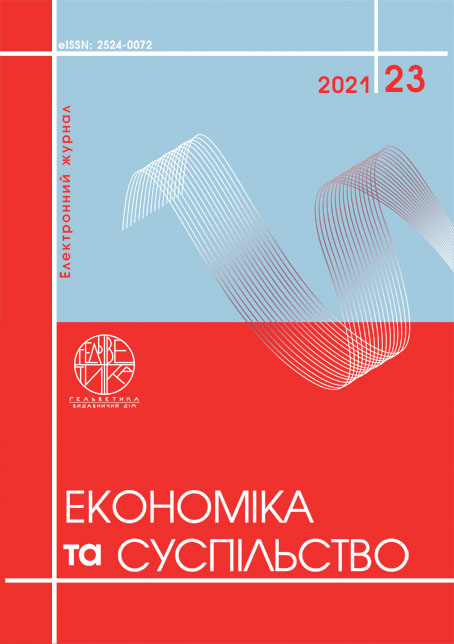FEATURES OF RURAL DEVELOPMENT GREEN TOURISM IN VINNITSA REGION
Abstract
In the context of globalization of economic life for the economy in the country remains relevant issue of manufacturing competitive products that meet international quality standards and ensure the economic security of the state. What are the prospects for agricultural production? Who should dominate it: a family farm that preserves the rural population and its historical traditions, or industrialized agricultural giants? The article considers ways of increasing the competitiveness of domestic rural tourism. Investigated advantages of the innovation cluster model for regional development based on a synergistic effect. At this stage for Ukraine, in general and Vinnitsa region, in particular, is very relevant research and implementation of innovative strategies to ensure effective development of tourism industry. Foreign experience shows that government support rural development, infrastructure, information, logistics systems. Special attention also deserves issue of certification and categorization. One of the important reasons for the study of foreign and domestic experience and create integrated organizations is to reduce transaction costs (advertising products, negotiation). Summarizes the problems that were highlighted at the national forum on rural / green tourism in the framework of the project of the NGO "development Center pangeya Ultima" with the support of the Embassy of Finland in Ukraine. The forum began effective cooperation of the Ministry of agrarian policy and food, the Department of tourism and resorts of Ministry of economic development and trade, local authorities, a significant number of scientific research institutions, educational institutions, tour operators, catering establishments. The advantages of creating an "Eco-center in the Wall" in the village of Wall of Vinnytsia region are analyzed. A project model of relations in the tourist and recreational cluster "Vinnytsia" is proposed, special attention is paid to the organization of recreation at home in rural areas, the manufacture of environmental products and the development of crafts.
References
Гібернау М. Ідентичність націй. Київ : Темпора, 2012. 304 с.
Вікінг М. Маленька книга хюге. Як жити добре по-данськи. Харків : Клуб сімейного дозвілля, 2017. 288 с.
Бігдан О.В. Напрями розвитку екологоорієнтованого агровиробництва у країнах Європейського Союзу. Агросвіт. 2013. № 4. C. 23–27.
Перегуда Є.Ф. Теоретичні аспекти диверсифікації сільськогосподарської діяльності підприємств АПК. Економіка АПК. 2013. № 10. C. 113–116.
Ходан І.В. Державна підтримка підприємництва: світовий досвід загального та особливого. Формування ринкових відносин в Україні. 2011. № 8 (123). С. 36–42.
Петрук В.Г. Екогеографія та екотуризм : Навчальний посібник. Вінниця : ТОВ «Нілан-ЛТД», 2016. 178 с.
Босий О. Священе ремесло. Традиційні символи і магічні ритуали українців. Вінниця: «Діло» ФОП Рогальська І.О., 2004. 220 с.
Проєкт «Image Mapping» Громадського об’єднання «Центр розвитку Пангея Ультіма». URL: http://www.pangeya.com.ua/index.php/ouractivities/ethno-tourism/208-im2015.html. (дата звернення: 20.01.2021).
Однорог М. «Маленькі Карпати» з каменю і легенд: історія села Стіна. URL: https://vezha.ua/malenki-karpaty-z-kamenyu-i-legend-istoriya-sela-stina-fotoreportazh (дата звернення: 20.01.2021).
Паулі Г. Синя економіка. 10 років, 100 інновацій, 100 мільйонів робочих місць. Доповідь Римського клубу. Київ : "Risk Reduction Foundation", 2012. 320 с.
Дармостук Д.Г. Розвиток сільського туризму через створення туристичних кластерів. Теорія та практика державного управління. 2016. № 4 (55). С. 1–6.
Hibernau M. (2012) [Identychnist natsii]. Identity of nations. Kyiv: Tempora. 304 p. (in Ukrainian)
Vikinh M. (2017) The Little Book of Hugo. How to Live Well in Danish. [Hugh's little book. How to live well in Danish]. Kharkiv: Family Leisure Club, 288 p.
Bihdan O.V. (2013) Napriamy rozvytku ekolohooriientovanoho ahrovyrobnytstva u krainakh Yevropeiskoho Soiuzu. [Directions of development of ecologically oriented agricultural production in the countries of the European Union]. Ahrosvit, no. 4, pp. 23–27.
Perehuda Ye.F. (2013) Teoretychni aspekty dyversyfikatsii silskohospodarskoi diialnosti pidpryiemstv APK. Theoretical aspects of diversification of agricultural activities of agricultural enterprises]. Ekonomika APK, no. 10, pp. 113–116.
Khodan I.V. (2011) Derzhavna pidtrymka pidpryiemnytstva: svitovyi dosvid zahalnoho ta osoblyvoho. [State support of entrepreneurship: world experience of general and special]. Formuvannia rynkovykh vidnosyn v Ukraini, no.8, pp. 36–42.
Petruk V.H. (2016) Ekoheohrafiia ta ekoturyzm [Ecogeography and ecotourism]: Navchalnyi posibnyk. Vinnytsia, 178 p. (in Ukrainian)
Bosyi O. (2004) Sviashchene remeslo. Tradytsiini symvoly i mahichni rytualy ukraintsiv. ekoturyzm. [Sacred craft]. Traditional symbols and magical rituals of Ukrainians. Vinnytsia, 220 p. (in Ukrainian)
Proiekt «Image Mapping» Hromadskoho obiednannia «Tsentr rozvytku Panheia Ultima». (2020) [Image Mapping Project of the Pangea Ultima Development CenterNGO]. Avaiable at: http://www.pangeya.com.ua/ index.php/ouractivities/ethno-tourism/208-im2015.html. Retrieved from: (accessed 20 January 2021).
Odnoroh M. (2018) «Malenki Karpaty» z kameniu i lehend: istoriia sela Stina. ["Little Carpathians" of stone and legends: the history of the village of Wall]. Avaiable at: https://vezha.ua/malenki-karpaty-z-kamenyu-i-legend-istoriya-sela-stina-fotoreportazh. Retrieved from: (accessed 20 January 2021).
Pauli H. (2012) Synia ekonomika. 10 rokiv, 100 innovatsii, 100 milioniv robochykh mists. [Blue economy. 10 years, 100 innovations, 100 million jobs]. Dopovid Rymskoho klubu, Kyiv: Risk Reduction Foundation, 320 p. (in Ukrainian)
Darmostuk D.H. (2016) Rozvytok silskoho turyzmu cherez stvorennia turystychnykh klasteriv. [Development of rural tourism through the creation of tourist]. Teoriia ta praktyka derzhavnoho upravlinnia, no. 4 (55), pp. 1–6.


